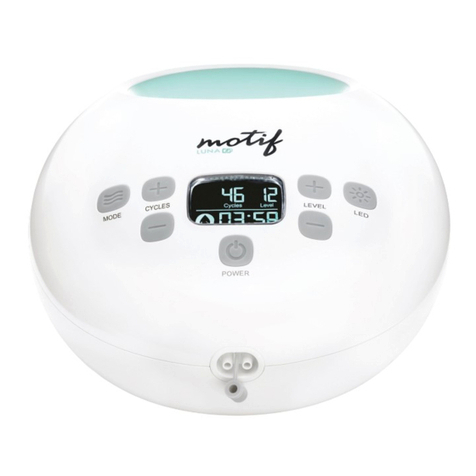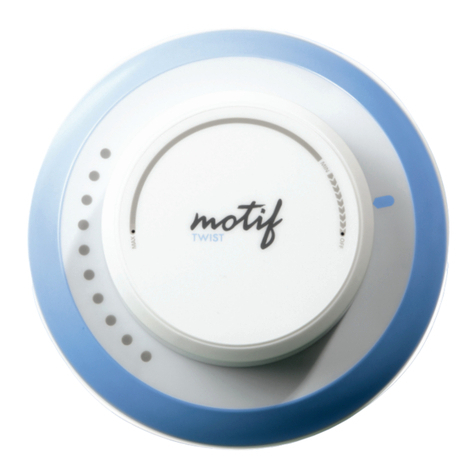
9Motif Medical® | BiliTouch Phototherapy Blanket | Operational Manual
8
The following symbols and safety signs are placed on product, label, packing and this
manual in order to stand for the information about:
4. Symbols
Symbol Standard/Symbol Reference No. Description
ISO 7010 — Graphical symbols — Safety colors
and safety signs — Registered safety signs /
W001
Used to display safety information for warnings.
Before using the Phototherapy Blanket, please be fully understand the
information provided with the device.
ISO 15223-1, Medical Devices — Symbols to be
used with medical device labels, labeling and
information to be supplied – Part 1: General
requirements / 5.4.4
Used to display safety information for caution.
Before using the Phototherapy Blanket, please be fully understand the
information provided with the device.
IP21
IP22
IP23
IEC 60529 Degrees of protection provided by
enclosures
Indicates the protection level against the ingress of solid object and
liquid.
IPX1 is protection against some falling water drops vertically.
IPX3 is protection against spraying water at any angle up to 60° from the
vertical shall.
IPX2 is protection against some falling water drops vertically when
enclosure tilted up to 15°.
IP2X is protection against solid foreign object like a finger.
ISO 15223-1, Medical Devices — Symbols to be
used with medical device labels, labeling and
information to be supplied — Part 1: General
requirements / 5.4.3
Refer to operation manual. Read manual before placing the device.
IEC 60417 — Graphical Symbols for Use on
Equipment / 5032 IEC 60417 — Graphical Symbols for Use on Equipment / 5032
IEC 60417 — Graphical Symbols for Use on
Equipment / 5031 IEC 60417 — Graphical Symbols for Use on Equipment / 5031
SN
ISO 15223-1, Medical Devices — Symbols to be
used with medical device labels, labeling and
information to be supplied – Part 1: General
requirements / 5.1.7
Indicates the serial number of the device.
REF
ISO 15223-1, Medical Devices — Symbols to be
used with medical device labels, labeling and
information to be supplied – Part 1: General
requirements / 5.1.6
Indicates a reference number.
Warning: Can lead to serious injury or death
• If the device falls into water, do not touch any electrical
appliances and immediately disconnect the power
from the power outlet.
• Use the Phototherapy Blanket for neonatal jaundice
treatment only as the intended use described in this
manual.
• Keep the device out of direct sunlight.
• The Phototherapy Blanket and accessories are not
heat resistant. Avoid contact with radiators, open
flames, or heated surfaces.
• Supervision is required when using the device near
children or pets. Keep all parts out of reach when not
in use.
• Eye protection: Do not look directly into the LED. During
treatment, always protect your baby’s eyes with an eye
patch or protective equipment. Periodically, check the
hospital or treatment protocol and makes sure that
the baby’s eyes are protected from contamination.
Patients near the light should use protective pads or
equipment to protect their eyes.
• Sensitive people may develop headaches, nausea, or
mild dizziness if left in the irradiated area for too long.
Wearing yellow lens glasses can reduce the potential
impact.
• Bilirubin Photo isomers may have toxic effects.
• Water balance: Water balance may be disturbed for
some patients.
• Photosensitive Drugs: Irradiation may reduce the
effectiveness of light-sensitive drugs. Do not store the
medication near light irradiation.
• Flamable gas: Do not use the light near combustible
gases. (eg oxygen, nitrogen dioxide, or other
anesthetics)
• Power off: When cleaning the light source, always turn
off the power and remove the power cable.
• Even an adult may be affected by staying in the light
for a long time.
• Do not use flammable solution directly on the LED
lamp. The LED lamp may be damaged or its function
may deteriorate. For cleaning or maintenance, follow
the instructions described in chapter 10 of this manual.
• Use of the wrong LED or accessories not provided by
Motif Medical®may damage the LED and cause injury
to the user or patient.
• Using a reflective film can cause an increase in
body temperature when the film affects a type of
phototherapy radiation.
Caution: Can lead to minor injury or product/
property damage
• There should be no material (ex. Blanket, clothes,
etc.) between the covered light pad and the patient.
Covered light pads should always be on bare skin.
• Patients should always wear diapers. This is especially
important for male patients because prolonged
exposure to light on the male genitals can be harmful.
• Treatment should be as directed by the doctor.
• Do not let the device come into contact with liquids.
• Do not throw or shake the device.
• If the device is crushed or damaged, such as a hole,
stop using it.
• When charging the device, connect the AC adapter to
the control box and charge it until the battery charging
stage indicator shows full.
• The Phototherapy Blanket is a non-transit-operable
equipment that can be used at home.
• Lay operators (non-experts, people who are not good
at operating the machine) can also operate.
• The patient’s condition should be monitored during
phototherapy.
• During phototherapy, the patient’s body temperature
should be monitored.
• Do not place drugs or fluids in the irradiated area.
• While the Phototherapy Blanket is in operation, wear
protective equipment to protect the patient’s eyes, and
frequently check whether it is properly worn.
• Keep all components dry after cleaning and
disinfecting.
• When charging is complete, immediately disconnect
the power adapter from the device.
• The battery charging stage displayed on the LCD
may differ from the actual battery capacity. Use a fully
charged device whenever possible.
• If a low battery status is displayed, charge the battery
immediately.
• If you are not using the device for a long time, make
sure the battery is fully charged before keeping the
device.
• The Phototherapy Blanket can only be repaired or
replaced by qualified personnel.
3. SAFTEY INFORMATION





























